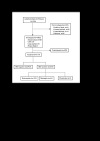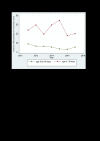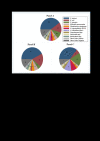Invasive bacterial disease in young infants in rural Gambia: Population-based surveillance
- PMID: 37772795
- PMCID: PMC10540664
- DOI: 10.7189/jogh.13.04106
Invasive bacterial disease in young infants in rural Gambia: Population-based surveillance
Abstract
Background: Invasive bacterial diseases (IBD) cause significant mortality in young infants. There are limited population-based data on IBD in young infants in Sub-Saharan Africa.
Methods: We conducted population-based surveillance for IBD among infants aged 0-90 days in a demographic surveillance area in rural Gambia between 1 March 2011 and 31 December 2017. Infants admitted to health facilities within the study area had standardised clinical evaluation plus conventional microbiological investigation. We defined IBD as isolation of pathogenic bacteria from blood, cerebrospinal fluid, lung, or pleural aspirate. We determined incidence, aetiology and case-fatality of IBD.
Results: A total of 3794 infants were admitted and 3605 (95%) had at least one sample collected for culture. We detected 254 (8.0%) episodes of IBD (bacteraemia 241; meningitis 14; pneumonia seven). The incidence of IBD in infants aged 0-90 days was 25 episodes/1000 person-years (95% confidence interval (CI) = 22-28), the incidence in neonates was 50 episodes/1000 person-years (95% CI = 43-58) and the incidence in infants aged 29-90 days was 12 episodes/1000 person-years (95% CI = 9-15). The most common pathogens causing IBD were Staphylococcus aureus (n = 102, 40%), Escherichia coli (n = 37, 15%), Streptococcus pneumoniae (n = 24, 9%) and Klebsiella pneumoniae (n = 12, 5%). Case-fatality was 29% (95% CI = 23-37) in neonates and 19% (95% CI = 11-29) in infants aged 29-90 days. A minimum of 7.3% of all young infant deaths in the population were caused by IBD.
Conclusions: IBD are common in young infants in rural Gambia and have a high case-fatality. Strategies are needed to prevent IBD in young infants. Overcoming barriers to widespread implementation of existing vaccines and developing new vaccines against the most common pathogens causing IBD should be among top priorities for reducing the high mortality rate in young infants.
Copyright © 2023 by the Journal of Global Health. All rights reserved.
Conflict of interest statement
Disclosure of interest: The authors completed the ICMJE Disclosure of Interest Form (available upon request from the corresponding author) and disclose no relevant interests.
Figures



References
-
- United Nations Inter-Agency Group for Child Mortality Estimation. Levels & trends in child mortality: report 2021. New York: United Nations Children’s Fund; 2021.
LinkOut - more resources
Full Text Sources
